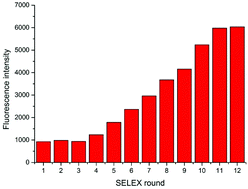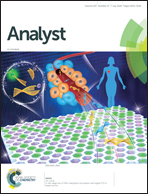Selection of DNA aptamers and establishment of an effective aptasensor for highly sensitive detection of cefquinome residues in milk†
Abstract
Cefquinome (CFQ), which is a fourth-generation cephalosporin approved for veterinary use only, has been widely used for treating porcine or bovine respiratory infection, bovine mastitis and other diseases. However, the antibacterial effect of CFQ is based on the duration of drug concentration remaining in excess of the minimum inhibitory concentration in serum or tissues, thereby inevitably leading to CFQ residues with high levels in animal-sourced food. In this paper, four CFQ-specific ssDNA aptamers were selected via a magnetic bead-based systematic evolution of ligands by the exponential enrichment (SELEX) method. Aptamer W1 with the lowest dissociation constant (Kd) value of 40.13 ± 22.11 nM was chosen for establishing a fluorescence aptasensor based on magnetic separation and release of molecular beacons for detection of CFQ residues. This aptasensor exhibited a high sensitivity toward CFQ with a limit of detection (LOD) of 0.09 ng mL−1 (linear range from 0.5 to 150 ng mL−1). Moreover, the present aptasensor also showed high selectivity against ampicillin and CFQ's structural analogs (i.e., cefpirome sulfate and cefixime). Finally, this aptasensor was used to detect CFQ in real spiked milk. The recovery rate of CFQ from spiked milk samples ranged from 96.6% to 103.2%. These results indicated that the developed aptasensor is a promising, highly sensitive and specific method for CFQ residue detection in animal-sourced food.



 Please wait while we load your content...
Please wait while we load your content...